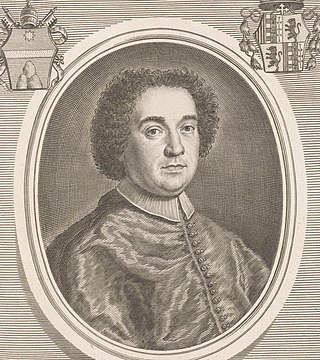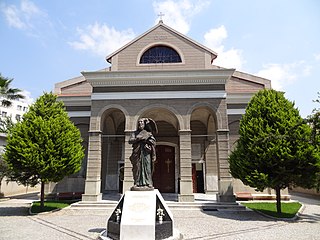
The Latin Patriarchate of Constantinople was an office established as a result of the Fourth Crusade and its conquest of Constantinople in 1204. It was a Roman Catholic replacement for the Eastern Orthodox Ecumenical Patriarchate of Constantinople and remained in the city until the reconquest of Constantinople by the Byzantines in 1261, whereupon it became a titular see. The office was abolished in 1964.

The Patriarch of Venice is the ordinary bishop of the Archdiocese of Venice. The bishop is one of only four patriarchs in the Latin Church of the Catholic Church. The other three are the Patriarch of Lisbon, the Patriarch of the East Indies and the Latin Patriarch of Jerusalem. Presently, the only advantage of this purely formal title is the bishop's place of honor in papal processions. In the case of Venice, an additional privilege allows the patriarch, even if he is not a cardinal, the use of the colour red in non-liturgical vestments. In that case, the red biretta is topped by a tuft, as is the custom with other bishops who are not cardinals.
The Archbishop of Nazareth is a former residential Metropolitan see, first in the Holy Land, then in Apulian exile in Barletta, which had a Latin and a Maronite successor as titular sees, the first merged into Barletta, the second suppressed.

Francesco Canali was an Italian cardinal. He was the Titular Archbishop of Larissa.

The Archdiocese of Naples is a Latin archdiocese of the Catholic Church in southern Italy, the see being in Naples. A Christian community was founded there in the 1st century AD and the diocese of Naples was raised to the level of an Archdiocese in the 10th century. Two Archbishops of Naples have been elected Pope, Paul IV and Innocent XII.

Giovanni Vincenzo Acquaviva d'Aragona was a Cardinal of the Roman Catholic Church. He became bishop of Melfi and Rapolla in 1537.

Francesco Acquavivad'Aragona was an Italian Cardinal, who served as ambassador of Spain to the Holy See.

The Roman Catholic Metropolitan Archdiocese of Izmir is a Latin archdiocese of the Roman Catholic Church in Asian Turkey (Anatolia).

The Diocese of Conversano-Monopoli is a Latin diocese of the Catholic Church in Apulia. It has existed since 1986, when the diocese of Monopoli was united with the historic diocese of Conversano. The diocese is a suffragan of the Archdiocese of Bari-Bitonto.

The Archdiocese of Monreale is a Latin archdiocese of the Catholic Church in Sicily. As of 2000 it is no longer a metropolitan see, and is now a suffragan of the Archdiocese of Palermo.

The Archdiocese of Tiranë–Durrës is a Latin Church Metropolitan archdiocese of the Catholic Church in Albania.
The Metropolis of Larissa and Tyrnavos is a Greek Orthodox metropolitan see in Thessaly, Greece.
The Roman Catholic Diocese of Alessano was a Roman Catholic diocese in Italy, located in the city of Alessano, in the province of Lecce, part of Apulia region of south-east Italy. On 28 June 1818, it was suppressed to the Diocese of Ugento.
The Diocese of Venafro was a Roman Catholic diocese in Italy, located in Venafro, province of Isernia, region of Molise in the ecclesiastical province of Capua. In 1852, the dioceses of Isernia and Venafro were united under the governance of one and the same bishop, aeque personaliter. The diocese of Venafro was permanently suppressed on 30 September 1986.
The Diocese of Bitetto was a Roman Catholic diocese in Italy, located in the town of Bitetto in the province of Bari, Apulia, Italy. In 1818, it was suppressed to the Diocese of Termoli.
Giovanni Antonio Acquaviva d'Aragona was a Roman Catholic prelate who served as Bishop of Lecce (1517–1525) and Bishop of Alessano (1512–1517).

Troiano Acquaviva of Aragon was an Italian cardinal and Catholic archbishop. Acquaviva was from a noble family with close ties to the Spanish crown; he was the nephew of Cardinal Francesco Acquaviva d'Aragona. Created cardinal in 1732, the following year he became cardinal-protector of Santa Cecilia in Trastevere, for which he provided a new façade. In 1734 King Philip V of Spain appointed him Spanish ambassador to the Holy See.
Antonio Spinelli, C.R. was a Roman Catholic prelate who served as Bishop of Melfi e Rapolla (1697–1724).
Carolus Polodig (1671–1714) was a Discalced Carmelite and a prelate of the Roman Catholic Church who served as Vicar Apostolic of Izmir (1713–1714) and Titular Archbishop of Cyrrhus (1713–1714).
Gregorio Giuseppe Gaetani de Aragonia (1643–1710) was a Roman Catholic prelate who served as Titular Patriarch of Alexandria (1695–1710), Apostolic Nuncio to Florence (1676–1678), and Titular Archbishop of Neocaesarea in Ponto (1676–1695).
This page is based on this
Wikipedia article Text is available under the
CC BY-SA 4.0 license; additional terms may apply.
Images, videos and audio are available under their respective licenses.












